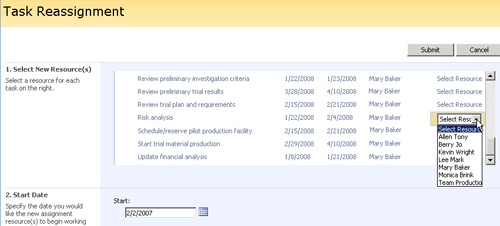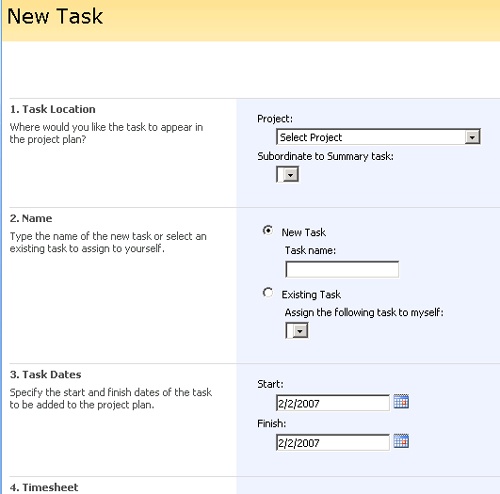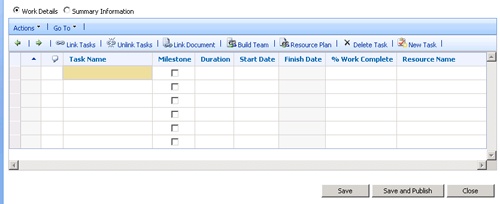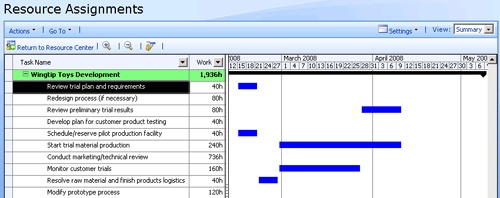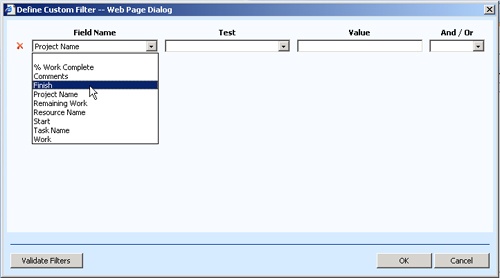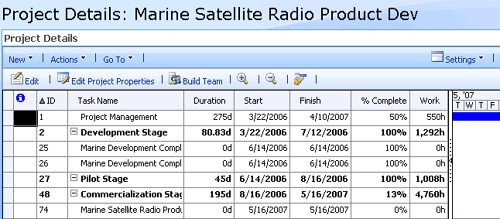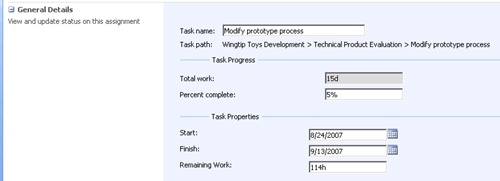When the project plan is developed and tasks are assigned to resources, the project manager publishes the project plan to the project server. Then when you log on to Project Web Access, you see the tasks from that project that have been specifically assigned to you.
When working with your assignments, you can do the following:
Review your new assignments and any changes to existing assignments
Assign yourself to team tasks or reassign your tasks to other resources
View the full project plan to see the context of your work
Enter and submit progress information about your assignments
As soon as you log on to Project Web Access, your home page lists any new notifications that require your attention. Notifications come from new or changed assignments or progress requests published to the project server for you by the project manager. The following are examples of notifications or reminders you might see in the Project Web Access home page (see Figure 23-5):
New tasks have been assigned to you.
Task information on an existing assignment has changed.
The project manager is requesting a progress update on your assignments.
A status report is coming due.
When you want to see more details about one of the notifications, simply click the notification link. The page containing the details of the notification appears.
The home page always includes notifications when a new task has been assigned to you. Click the notification link, and the My Tasks page appears. The other way to open the My Tasks page is to click My Tasks on the Quick Launch task bar.
The My Tasks page shows your list of tasks along with the fields appropriate to the progress tracking method that has been chosen by the project server administrator and your project manager. Typical fields might include the amount of scheduled work for each assignment, scheduled start date, scheduled finish date, and percentage complete.
When you receive new task assignments, they are marked with the !New assignment icon next to the task name. You don’t need to take any further action to accept your new assignments. You can review the summary information on the page, or you can click the task name and review additional assignment details such as other resources assigned, predecessor and successor tasks, and notes (see Figure 23-6).
All projects you are working on, even those owned by different project managers, show on your My Tasks page. By default, all your assignments are grouped by project.
Also by default, only assignments for the current period are listed. If you want to see all your assignments, first make sure that you have saved any changes to your assignments. Below the table, click Save All. click Settings, View Options. Clear the Show Only Current Tasks check box and then click Apply.
On occasion, you might find it necessary to reject an assignment. Maybe the assignment is a duplicate of another one you already have. Maybe you feel you’re not qualified to carry out the assignment. Maybe you have a scheduling conflict and cannot do it during the required time. Whatever the reason, if you need to reject an assignment, follow these steps:
On the My Tasks page, select the check box next to the assignment(s) you need to reject.
On the toolbar above the table, click Delete.
Click OK in the alert that appears.
A strikethrough line appears through the assignment row.
Below the table, click Submit Selected.
A dialog box prompts you to enter a comment about the task update you’re about to submit.
Type a comment explaining to the project manager your reason for rejecting the assignment and then click OK.
Entering a comment is not required to reject an assignment; however, it is a good communications practice.
This comment will be stored as a transaction comment with the assignment and can be seen on your Assignment Details page in the Transaction Comments And Task History section.
This task update will appear on the project manager’s Task Updates page, along with the comment you entered. If the project manager accepts your update, the project plan is changed to remove you as an assigned resource on the task. The project manager will then likely assign another resource to the task.
However, if the project manager rejects your update, the assignment will come back to you. In this case, the project manager is, in effect, rejecting your rejection of the assignment, and the project plan will remain unchanged in this regard. The strikethrough line is removed from the assignment on your My Tasks page, and the assignment is marked with the Update Rejected icon. If the project manager entered a comment about the reason for the rejection, you can read it on the Assignment Details page in the Transaction Comments And Task History section.
During the course of a project, task information often changes. New tasks are added, durations change, and then there is a ripple effect for related tasks throughout the project. When the project manager publishes the project with the changed tasks, if any of your assignments are affected, they are marked with the Assignment Updated icon in the indicators column on the My Tasks page.
Review the assignment information in the table—the cells of changed information are highlighted with another color. You can also click the assignment name to review the details.
If the Notes icon appears with an assignment, either you or the project manager has added a note about the task. Double-click the icon to read the note. You can respond to or add to the note by clicking in the lower pane. When you submit this task, the note appears on the project manager’s Task Updates page. When the project manager accepts your task update, your note shows as a task note in the project plan.
By default, resources can transfer an assignment to another resource. This can be useful in groups that are used to shifting workload according to the skills, availability, and preferences of members in the group. This can also be useful in organizations in which a team lead or resource manager decides who should handle a particular assignment. In such a case, the project manager can assign the task to the team lead or resource manager, and that individual then reassigns the task to the right person.
This function is made possible by permissions set by the project server administrator. The individual project manager can also allow or disallow task reassignment.
Note
In Microsoft Office Project 2003, you could delegate a task to another resource and choose whether you see update information about the task. In Microsoft Office Project 2007, a resource can reassign a task to another resource. Those with resource manager privileges can review task updates, status reports, and timesheets.
If you have the capability to reassign tasks, do so by following these steps:
On the My Tasks page, click Reassign Work.
On the Task Reassignment page, in the Select New Resource(s) section, find the task you want to reassign.
Click in the Select Resource box to see the list of resources for this project (see Figure 23-7).
Change the Start Date or enter a comment if necessary.
The project manager will see your comment when reviewing the task update reflecting this reassignment. Unless the reassignment is routine, it’s a good idea to explain your reason for the reassignment.
Click Submit.
This task update will appear on the project manager’s Task Updates page as a task reassignment request. If the project manager accepts the update, the project plan is changed to show the reassigned resource on the task. If the project manager rejects the update, the assignment will return to you, and project plan remains unchanged.
You can assign yourself to existing tasks you see in the project that you want to work on. If you’re a member of a team assignment pool, you can assign yourself to a task assigned to a team of which you are a member.
You can also propose an entirely new task for a project you’re working on and assign yourself to it. You can also create a mini-project or to-do list for your own personal use.
Your project manager might have published project information without assigning tasks to resources. By default, you can assign yourself to tasks in a published project in which you are a resource.
To see all the tasks in a project, first click Project Center on the Quick Launch task bar. Click the name of the project. The project details appear, including the task names. Take note of the summary task that contains the task you want to assign yourself to.
Once you have this information, you can assign yourself to the task by following these steps:
On the My Tasks page, click New, Task.
The New Task page appears (see Figure 23-8).
In the Task Location section, click the project name.
The Project drop-down list includes all the projects in which you are a resource.
In the Subordinate To Summary Task box, click the name of the summary task that contains the task you want to assign yourself to.
In the Name section, select the Existing Task option.
In the Assign The Following Task To Myself box, click the task you want.
This box contains the list of tasks under the summary task you selected in step 3.
Complete the fields on the rest of the page as appropriate.
When finished, click Submit.
Your request will appear on the project manager’s Task Updates page as a new assignment request. If the project manager accepts your request, the project plan is changed to show you as an assigned resource on the task.
Instead of selecting and assigning an individual to a task, sometimes a project manager prefers to specify that a particular department or group be responsible for the task.
Members of that group can then decide for themselves who will actually carry out the assignment.
This is the idea behind team assignment pools, also known as team resources, a new feature in Microsoft Office Project 2007. A team assignment pool might be a department, such as Business Development, or a group of individuals doing the same job, such as Analysts. When a project manager assigns a task to a team resource, that task is considered a team task.
Note
For you and your project manager to be able to use team resources, your project server administrator needs to have defined the team assignment pool in the enterprise resource pool. The administrator also needs to have identified you as a member of the team assignment pool.
To assign assign yourself to a team task, follow these steps:
On the My Tasks page, click Self-Assign Team Tasks.
Any tasks that have been assigned to the team to which you belong are listed in the table on the Team Tasks page.
Select the check box next to the team task to which you want to assign yourself.
Click Assign Task To Me.
To return to the My Tasks page, click Go To, Tasks.
The team task is now listed as one of your assignments. The project manager is notified on the Task Updates page.
Suppose you’re working on a project and you see that a task should be added. To propose the task to your project manager and to ensure that your work on the project is accounted for, you can create and submit a new task to the project manager.
To propose a new project task, do the following:
Identify where the new task might belong in the context of the whole project. Click Project Center on the Quick Launch task bar and then click the name of the project. On the Project Details page, take note of the summary task that should contain the new task you are proposing.
On the Quick Launch task bar, click My Tasks.
On the My Tasks page, click New, Task.
The New Task page appears.
In the Subordinate To Summary Task box, click the name of the summary task under which your proposed task should be added.
In the Name section, be sure that the New Task option is selected.
Complete the fields on the rest of the page as appropriate.
When finished, click Submit.
The new task appears in your task list. Your request also appears on the project manager’s Task Updates page as a new task request. If the project manager accepts your request, the new task is added to the project plan with you as the assigned resource.
In the course of carrying out your assignments, you might have a number of smaller activities that aren’t big enough to be called tasks. With an activity plan, you can create a to-do list or mini-project for yourself to keep track of these kinds of tasks. Although an activity plan is stored on your project server, it has no connection to any project plan.
To create an activity plan, follow these steps:
On the My Tasks page, click New, Personal Activity.
The New Activity page appears.
Near the top of the page, make sure that the Summary Information option is selected.
In the Name And Description section, enter a name for your activity plan. Type a description if you want and then enter the start date.
In the Project Custom Fields section, complete the field information for any custom fields you want to add to your activity plan.
When finished, click Save.
The new activity plan is saved to your project server, and the Work Details view of your new activity plan appears. Make sure that the Work Details option is now selected (see Figure 23-9).
Enter the details of your activity plan. Enter task names and durations. Use the buttons on the toolbar to indent outline levels or insert new tasks as needed.
If you want to link tasks with a finish-to-start task relationship, select the predecessor task by clicking the row header. Hold down Ctrl and then click the row header for the successor task. Click the Link Tasks button.
An icon in the indicators field shows that the two tasks are linked. In an activity plan, you can only link tasks with a finish-to-start task relationship.
Click Save to save the activity plan to the project server but keep it to yourself. Click Save And Publish to save the activity plan to the project server and also make it available for others to see and use.
Unpublished activity plans are useful when you just need to keep a personal to-do list for yourself. Published activity plans are useful when used as a mini-project that you want to be able to share with other resources.
When finished working with your new activity plan, click Close.
Your activity plan is listed on the Proposals And Activities page. If you published the activity plan, others will be able to open it. If you only saved the activity plan without publishing it, only you can see it in the list.
To view and change summary information or change task details about your activity plan, follow these steps:
On the Quick Launch task bar in Project Web Access, under Projects, click Proposals And Activities.
On the Proposals And Activities page, click the name of your activity plan.
By default, the Work Details view of the activity plan appears.
Make any changes you want to the task information and then click Save.
If you need to view or change summary information, above the table, select the Summary Information option.
The Summary Information view of your activity plan appears. In this view, you can review or change the activity plan description, the start date, the activity plan owner, and so on.
When finished, click Save or Save And Publish. Click Close.
Note
For information about adding resources to an activity plan or converting an activity plan to a project, see the section titled Creating Proposals and Activity Plans in Chapter 22.
The My Tasks page is your hub for your project assignment information and is likely the place where you spend the most time when working in Project Web Access.
On the My Tasks page, you can update progress information. You can show all your assignments or just the ones for the current period. You can switch to a Gantt Chart view and then view, filter, and group your assignments. You can print a table or export it to Excel.
Note
In Microsoft Office Project 2003 and earlier versions, the My Tasks page was is called the Timesheet. In Microsoft Office Project 2007, there is a new page with specific Timesheet functions separate from those on the My Tasks page.
Although the fields in the table of the My Tasks page show the summary information for your assignments, you can see and update specifics by clicking the assignment name to open the Assignment Details page. Here you can:
Update progress information.
Review the history of communications on this assignment between you and the project manager.
Review any issues, risks, or documents associated with this task.
See a list of and send e-mail to the other resources on this project.
Review this task’s predecessors and successors.
Read and respond to task notes stored with this task in the project plan.
In certain fields in the My Tasks summary table, you can also enter progress tracking information, for example, % Complete or Remaining Work. You can simply double-click in the field and change the value.
Certain types of custom fields might have been created and added to your Tasks list by the project manager or project server administrator. Some of these custom fields can contain a value list from which you can choose an appropriate option. If such a custom field is part of your Tasks list, and if you have read-write permission, click in the field. A drop-down list shows all the choices. Click a choice, and that value now appears in the field. This procedure makes it easy for you to enter the correct form of information while maintaining project data integrity.
You can customize your view of assignments to show, hide, or sort information, as follows:
To show only tasks for the current time period in your Tasks list, click Settings, View Options. Select the Show Only Current Tasks check box. This check box is selected by default.
To show all tasks to which you are assigned, clear the Show Only Current Tasks check box.
You can sort assignments by a field in the Tasks table—for example, by Task Name or Finish Datemjn. To do this, click the heading of the field column you want to sort by. The field is sorted in either ascending or descending order. To sort in the other direction, click the column heading a second time.
You can switch to a Gantt chart view of your assignments. In the My Tasks page, click Go To, Tasks Gantt View. A Gantt chart showing your assigned tasks appears (see Figure 23-10).
On this page, you can:
Click a task and quickly display the Gantt bar for it by clicking Scroll To Task.
Zoom the chart area in to expand the length of the Gantt bars and see shorter increments of time, for example, from days to hours.
Zoom the chart area out to compress the length of the Gantt bars and see larger increments of time, for example, from days to weeks.
To return to the My Tasks page, click the Back button on your browser.
In the Gantt view, you can filter, group, or search your assignments by criteria you choose.
To filter assignments via a built-in filter, follow these steps:
On the Quick Launch task bar, click My Tasks.
Click Go To, Tasks Gantt View.
Click Settings, Filter.
In the filter pane that appears above the Gantt chart, click Custom Filter.
In the Define Custom Filter dialog box, in the Field Name box, click the field you want to filter by, for example, % Work Complete or Finish (see Figure 23-11).
In the Test field, enter the test criteria, for example, Equals or Contains.
In the Value field, enter the value for the field and then click OK.
The task list changes immediately to show only those tasks that meet your filter criteria.
To see all tasks again, click All Assignments in the Filter box.
You can also select the AutoFilter check box to add the AutoFilter arrows to each column in the Tasks table. Click one of the arrows and then select a value by which to filter the list. To see all tasks again, click the AutoFilter arrow and then click (All).
To group assignments by a particular field, follow these steps:
On the Quick Launch task bar, click My Tasks.
Click Go To, Tasks Gantt View.
Click Settings, Group.
In the group pane that appears, click the arrow in the Group By box to see your grouping choices in the drop-down list.
Click the field you want to group by.
The task list changes to reflect your grouping.
If you want a subgroup within the group, click the second field in the Then By box.
When you want to return to the original nongrouped order, click None in the Group By box.
To search for an assignment on this page, click Settings, Search. Search controls appear in a pane.
To close the Filter, Group, or Search pane, click the X (close) button in the upper-left corner of the pane.
By default, you can review a list, the summary information, and component task information for all the published projects in which you’re a resource. This is helpful to see the overall context of your assignments.
To review information about projects you’re working on, follow these steps:
On the Quick Launch task bar, click Project Center.
The Project Center page appears. The projects are listed in a summary project Gantt Chart (see Figure 23-12). Summary information typically includes the project start and finish dates, percentage complete, amount of work, and the owner or project manager.
Click the link for the project whose tasks you want to review.
The Project Details page appears (see Figure 23-13). The tasks, along with their durations, start and finish dates, and current progress are listed.
Depending on your user permissions and how your project server administrator has set up views, you might be able to review the project by different sets of information. In the upper-right corner of the Project Center or Project Details page, click the View box and review your choices.
You can also open the Web-based workspace for the project, a new feature in Project 2007 based on Windows SharePoint Services. In the workspace, you can read announcements or calendar information. You can see any documents, issues, or risks associated with the project. You can view and participate in discussions about the project. To open a project workspace, from the Project Details page, click Go To, Project Workspace. The workspace opens in a separate Web browser.
Note
By default, Project Web Access resources are set up with the permission to view documents, issues, and risks. Depending on how the administrator has set up Project Server and Windows SharePoint Services, resources might also have the permission to add and edit risks, issues, and documents.
Note
For more information, see the section titled Managing Documents, Risks, and Issues in Chapter 22.
After your assignments are established, you’re ready to work on those tasks. Of course, your project manager wants to be informed periodically of what you’re accomplishing, as well as any snags you might be running into. You will provide up to three categories of progress information, depending on your organization’s time and status tracking requirements:
Specific work hours or percentage complete on your individual assignments, also known as actual work, or actuals
Text-based status reports in a format set up by your project manager
Hours or days spent on different categories, such as billable and nonbillable time, nonproject administrative time, nonworking time, and so on
While you work on your assignments, it’s good practice for you to keep your My Tasks page updated. At the end of each day, for example, you can log the percentage complete, the remaining time on an assignment, or the number of hours worked on each task. Which of these three you update depends on how your My Tasks page has been set up by your project server administrator.
If all the fields you need to update are showing in the assignments table on the My Tasks page, you can double-click the value in a particular field and type the new value. Or, click the assignment name to open the Assignment Details page. In the General Details section, update the appropriate fields. When finished, click the Save All button below the table. This saves your information without submitting it for review by your project manager.
Keeping your assignment progress information up to date each day will make it all the easier for you to quickly send a progress update when your project manager asks for it.
As soon as you have assignments on your My Tasks page, you have the ability to submit progress updates. Your project manager and the rest of the project team might have agreed on when progress updates should be submitted, for example, every Friday at noon or the last day of each month. Your project manager might submit a project update request at those times or just expect you to submit a project update without a reminder. Your project manager can also explicitly request progress updates at any time. Either way, such requests appear as a reminder on your Project Web Access home page, and you also receive an automated e-mail notification.
Whenever your project manager submits a progress update request, a question mark icon appears next to the assignment on the My Tasks page.
Note
The project manager who created the project is typically the project owner. By default, this project manager is also the status manager. A status manager different from the project manager can be designated for a project. This person is responsible for reviewing and accepting or rejecting progress updates and status reports for a project. You can see who the project manager and status manager are in the Contacts section of the Assignment Details page.
Submitting your progress updates, or actuals, on your individual tasks is the heart of the Project Web Access functions. Submitting your assignment actuals ensures that your project manager is well-informed about how you’re doing on your tasks and also knows whether you have too much work or whether you need more time or assistance. In addition, the actuals you submit help everyone on the project team anticipate potential problems or bottlenecks and come up with solutions before they become crises.
You’ve already seen how you submit changes to your assignments, such as when you reassign a task to another resource, or when you create a new task for the project. The project manager is notified of your task update and decides whether to reject your change or accept it for incorporation into the project plan.
Submitting progress updates containing your actuals works the same way. You enter your actuals on your assignments and then submit them to the project server. Your project manager reviews your actuals and accepts them. This acceptance then updates the progress information in the project plan.
To enter and submit a progress update of assignment actuals, follow these steps:
On the My Tasks page, click the assignment name to open the Assignment Details page.
Under Task Progress or Task Properties, enter actuals for your assignments in the fields designated for this purpose by your project server administrator and project manager.
If your project tracks percentage of work complete, the Task Progress section includes the Percent Complete field. Use this field to report percentage complete on each of your assignments at this point, for example, 15%, 50%, or 100% (see Figure 23-14).
If your project tracks total actual work and remaining work for the reporting time period, the section includes the Actual Work and Remaining Work fields. In the Actual Work field, enter the amount of time you spent on each assignment. In the Remaining Work field, enter the estimated number of hours needed to complete the assignment.
If your project tracks hours of work done per time period, time periods such as days or week are provided. In the timephased fields for each time period (day or week), type the amount of time you spent on each assignment.
You might do this for all your current assignments or for those assignments marked with the update request (question mark) icon. It’s perfectly fine to report on more assignments than the project manager requested. In fact, it’s good practice to submit an update whenever there is a significant change or accomplishment on an assignment.
To save the changes you’ve made to your tasks while still updating your actuals, click Save.
To submit your progress updates, on the My Tasks page, select the check boxes for all the assignments you want to submit and then click the Submit Selected button below the table.
The Submit Changes dialog box appears, in which you can type a comment regarding the task update. The same comment will show for all assignments in this group you’re submitting. Click OK.
The progress updates for your selected assignments are submitted to the project server and your project manager. When your project manager reviews and accepts your update, your actuals update the task progress information in the project schedule.
If you’re updating assignments from multiple projects or multiple project managers, you don’t need to do anything special. When you submit updates from multiple projects or for different project managers, the project server makes sure that the information is distributed to the correct managers and ultimately updates the correct project schedules.



